|
|
|
 |
|

I
|
|
YAK 52 |
CJ-6A |
|
Vne (kts) |
194 |
195 |
|
Econ Cruise (kts 60%) |
110 |
135 |
|
Fuel burn (lph 60%) |
60 |
55 |
|
Climb (fpm sl) |
1950 |
1250 |
|
Takeoff roll (m sl) |
180 |
280 |
|
Landing roll (m sl) |
350 |
350 |
|
G limits |
+7/-5 |
+6.5/-3.5 |
|
Fuel cap |
122 |
155 |
|
HP |
360 |
285 |
|
Wingspan (m) |
9.5 |
10.2 |
|
Length (m) |
7.7 |
8.5 |
| Landing Gear | Semi Retract | Trailing Link |
|
Endurance (min) |
120 |
170 |
The end of the cold clouds of war not only brought peace to the common man it brought affordable, reliable, enjoyable and available military flying. The kind of flying which brings tears to the eyes of those who love the sound of round engines, the scent of oil smoke and av-gas, the look of green painted top-sides over sky-blue underbellies, big numbers, checkerboard cowlings and nose art. Like rubbing down a spirited steeplechase horse, part of the Warbird ritual is tracing the lines of your aircraft with an oil rag after each flight, lubricating the meshing between pilot and machine which affirms both are living, breathing partners in a graceful dance so few humans can do.
The tragedy that is the civilian aircraft market today, the travesty that is the lack of preservation of past military inventory, and the lack of anything new that isn't a miniature homebuilt, makes the sudden availability of any type of military or current production, seriously-aerobatics, quasi-military inventory very attractive. So, out of the rubble of the Berlin Wall and the breach in the Great Wall of China, comes perhaps the greatest bundle of gifts American pilots have seen since 1942 when Uncle Sam handed 18 year old boys about-to-become- men the ignition keys to round-engine aircraft which would go straight up or straight down.
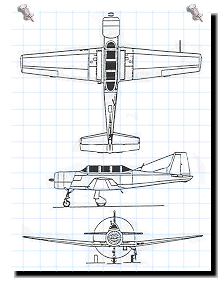 |
There are all types of
aircraft coming from the former Soviet Bloc, many of which are causing
concern with our FAA types. The opportunity to import ultra-high
performance jet aircraft carries with it a certain responsibility that
will be very difficult to control. $35,000 fighter jets for the common
man, Mc MiG-style, may ultimately hurt the opportunities available from
the increasing supply of excellent military and quasi-military aircraft
coming from both Eastern Europe and China. These new arrivals offer a
rewarding experience to the Warbird wannabe who is not in the big-bucks
range of your basic General Motors Vice President who flies his P-51 to
Reno with the other big boys. Out of the expanding pack of available Soviet bloc aircraft designs, but manufactured by their Oriental friends to the far east, comes the aircraft which will undoubtedly prove to be the civilian-available Warbird "aircraft of the decade". By modifying the original Yak 18 design from a five-cylinder, 160 hp radial, tail-wheel aircraft, the Mainland Chinese, ever mindful of their insurance rates and the basic ability of the average rice-paddy worker to transition from ox-cart to tail-dragger, transferred that third wheel to the nose, and over the years increased the size and horsepower of the power plant to nine cylinders and 285 hp. The evolution result is the sleek and spirited Nanchang CJ-6A . |
The CJ-6A is an all dural-aluminum plate and frame, flush-riveted, gull-winged, fully retractable, advanced aerobatics and instrument trainer which cruises up to a realistic 150 Kts while only withdrawing nickels and dimes from your bank account for fuel. The book says you can get down to 11 gals per hour at rpm settings of 1790 and speeds of about 120 kts, but a practical man would count on 12.5 to 13 gph at 2000 to 2100 rpm if he was flying against the endurance limits of his bladder at 150 kts.
The uninformed consensus of those who have yet to be introduced to foreign military aircraft is that, compared to US equipment, Soviet or Chinese aircraft would be more egg-crate in nature than bullet-proof. Wrong. Or in the case of the Chinese CJ-6A, "wong". The Chinese have been making this aircraft from the same basic blueprint for almost 50 years. Instead of trying to evolve a space shuttle out of a two-seat trainer, they set about to redesign each part that broke so it would be disabused to do so as frequently. It would seem that after at least 15 years of this pencil and eraser engineering the probability they will have succeeded should be high. In as much as they have been at it for more than twice that long, high it is.
While almost any year CJ-6A is a good design, certainly any aircraft manufactured after 1970 is a phenomenal example of simplistically good workmanship. It is built like the proverbial brick smoke shed, with trailing link landing gear and a pneumatic system rather than hydraulic for just about everything that moves. It has to be experienced to be believed. Starting the engine is a gas, literally. After the engine is primed, depression of the air start button "Pops" a charge of compressed air into the cylinder air distributor on rotation, forcing the pistons to move until combustion is sustained. There is no potential to run down the battery nor grind the starter, so cold weather starts are a snap, or in this case a loud "pop". If you prime and pop by the book, which was written over four and a half decades of "I'll try it my way attempts", she starts immediately to a smooth, throaty rumble that makes Warbird lovers weep with emotion.
The stock aircraft comes with a particular quirk in power management. While all other power and prop controls move in the same direction as US aircraft, forward for full-on and aft for full-off, the mixture control on the CJ-6A moves aft for full rich, the theory being that knee wobbling students, while attempting to land, might accidentally pull the mixture aft rather than the throttle. Have you ever done that in a U.S. aircraft? The inscrutable Chinese designers went even further by placing a tab on the throttle which engages the mixture so when the throttle is retarded, the mixture automatically follows to full rich, a lovely thought for the forgetful, but a headache for the competent pilot who notices quickly the plug fouling rate is high on the CJ6A if you taxi more than 50 feet from landing to your tie-down. Removal of that tab is the first recommended modification done by a new owner. Leaned to the most forward position produces sensually smooth operation at idle.
The air braking system is a joy. First impressions of the bicycle hand brake on the stick tend to reinforce the egg-crate theory, but one taxi later that impression is gone forever. Braking is fully differential. Depressing the rudder pedals to either side of neutral will give you brake pressure on either wheel or both depending upon rudder bar position. If you treat the brake handle like the front brake on a Harley Davidson you will never over-brake and will control direction and momentum with ease. The gear retracts and extends with lightning speed, air swooshing, external push rod indicators on the cowling and wings, respectfully called "idiot bars", telling you a lot is being accomplished in an orderly fashion. Confucius says: " If you land this bird with the gear up, you should be restricted from handling sharp instruments".
The counter-clockwise propeller rotation requires left rudder on take off, lots of it until the wheels clear, but nothing like an AT-6, for example. It is not squirrelly. The horsepower to weight ratio is really good, the aircraft originally weighs 2,400 pounds empty. After we remove 525 pounds of W.W.II type radios & shielded cabling the 285 hp stock engine provides some very good torque and plenty of pull. Left rudder or, at the least -neutral rudder, will be found in all power maneuvers even mild right hand climbing turns. She climbs quickly at 1500 ft/min. off the runway and an honest 1300 ft/min. through 6,000 ft at about 100 Kts. With 3,000 feet of sky between you and the ground there isn't any attitude in which you might place this aircraft which would preclude a recovery. This aircraft is very docile in forgiveness and very positive in responsiveness. In fact, the Chinese instructors have painted a white line vertically on the instrument panel and suggest, "any time aircraft out of control, place stick on white line, count six by thousand, and pull back till brown is below blue". This is reasonable advice, but it only applies to looking outside, the massive and quite accurate artificial horizon, while totally effective in any attitude, indicates in level flight that the brown is on top and the blue is below. When you view it in unusual attitudes you accept the position of the artificial aircraft either over brown or blue to mean going either down or up. The best advice is doing your unusual attitudes in clear skies.
Roll rate on this aircraft is about 150 degrees per second, and that is with very light stick pressures, not the two handed grip needed in the Yak 52. But if you are like most of us who love Warbirds, slow dancing is much more fun than the jerk and snatch MTV gyrations we see today, so barrel rolls, smooth loops, lazy split-S's, Cuban eight's, hammer-heads and all the variations available in-between, can be done as smooth as coating ice cream with chocolate syrup. The CJ6A will hold a cruising formation all day with a T-34 or an AT-6 at a fraction of the fuel burn but will turn inside almost anything you will encounter if your friends have heavy iron and want to play.
The dihedral of the wings create a significant wash-out at the tips which keeps the ailerons very effective down to its stall speed of about 62 Kts. The slightest increase in power or attitude airspeed will get you flying again immediately, so botched landings are easily avoided as we demonstrate regularly with my father, an 80 year old, ex-Eighth Air Force B- 1 7 commander and P-3 8 jock who can still fly me into knots but whose depth perception seems to move like a mirage image. The trailing beam landing gear is a Soviet innovation, one of the finest contributions to flying and makes all of us look like pro's.
Because the CJ6A is so aerodynamically smooth, it can enter most aerobatics maneuvers with surprisingly low energy. This factor makes any planned maneuver very graceful and recovery from those unplanned maneuvers easily accomplished. She will Hammerhead as if you are guiding the reins on a dressage horse, loop with so little energy a first time aerobatics passenger will hardly notice the "g" load, but will pull six of those "g's" with very light pressure and turn inside of itself when you want it to. She has no inverted oil system, but then neither does the AT-6 at a price of several hundred K. If you want to travel cross-country upside-down, join the circus. The CJ, like most military trainers, will keep a normal person suspended upside-down for as long as is enjoyable.
A particular engine saving feature is the collection of Gill Louvers attached to the inner ring of the cowling. These venetian blind type slats are controlled from inside the cockpit and were designed to trap engine heat inside the cowl for Siberian winter operations. When you are descending without power for extended periods, closing these Gill Louvers will trap all but a degree or two of heat even with power off, thereby reducing the shock cooling effect so debilitating to engines not so prudently protected. They are particularly helpful with our 100 octane low lead fuel. Trapping extra heat to raise the cylinder temperature to 180 degrees Celsius during cruise greatly reduces carbon build up and improves fuel burn.
In the beginning everyone with a Chinese uncle or exchange student in house thought they could import a CJ-6A. The aircraft was sought after solely for its low cost, and little or no attention was paid to the craftsmanship and flying characteristics of the aircraft. This fine aircraft is so much more than just cheap flying, it is poetry in e-motion and is finally receiving the attention it deserves.
Yakity Yak, Inc. changed all this. We convinced the Chinese government that it was poor policy to release derelict aircraft. Against this governmental promise we agreed to import a significant number of CJ-6As each year over the next five years. We are now the exclusive importer of this aircraft.
With this totally responsible approach, in the next ten years the value of the CJ-6A will increase on a curve similar to the T-34 over the last 10 years. Buy now, fly now, when you're too old to pass the medical, sell, and cash in the profits like a 401k program.
Who should want to own a CJ6A? My eighty year old father gets his thrills today by blacking me out in the rear cockpit. But then my father has such poor circulation these days that six "g's" just begins to put blood in his toes so he can feel his feet. I believe we've added five years to his life due to pure enjoyment. My wife has flown with me for thirty years and never expressed a desire to learn to control an aircraft until we purchased the CJ6A. Today she is starting her first acrobatic lessons. My son, who received his license when he was 16, now at 30 is flying everything he can to impress the airlines and is a far better pilot today by learning true stick and rudder flying in the CJ6A. My brother, who was a 16-year Navy jet-jock and for the last 10 years has been flying for Delta Airlines, so naturally has never had his feet on the rudder pedals. He first flew the CJ6A when I took him on a run inside the trees on the Willamette River nearby our field. When we landed he wrote a check for one from our next shipment. I have flown everything with a propeller on it known to man, the CJ6A changed my life because I can fly every day, in any attitude, in a beautiful bird I'm proud to be seen in and never feel guilty about what I have or will be spending.
Who really should own a CJ6A? If you're a person who always looks up when any aircraft flies over, or who will drop his tools to run outside when he hears a radial engine overhead; if you get a lump in your throat when the oil-breathing, ear-thumping Warbirds do their flyby at the local airshow, or if the first column you read in Trade-A-Plane is the Warbird section, you clearly need a CJ6A. If you are reading this and have never seen a Warbird in your life, but have a deep curiosity to learn what it is like to fly straight up or straight down, or to see the horizon roll in lazy circles; if you are an artist, a dancer or just a lover of life, you need a CJ. The CJ is a real Oriental Dream Machine and you'll sleep much better when you have one in your hangar.
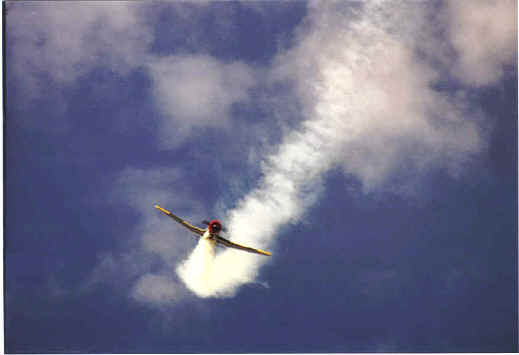
YOU DECIDE WHICH IS THE BETTER AIRCRAFT, THE YAK 52 OR THE CJ6.
Both are fine aircraft. The Yak 52 has a 360 hp engine with a wood and composite climb performance propeller, which cruises at 130 Kts at 18 gallons per hour for 1.3 hours; will do neat hammer-head stalls and aerobatics maneuvers at 8.0 positive and 3.0 negative "Gs", and will climb 300 fpm faster than the CJ-6A. (The buyer must be cognizant that there are 5.0 positive "G" limited aircraft out there and this is not always indicated by the seller) The CJ-6A has an all metal constant speed combination cruise and climb propeller attached to a 285 hp engine which burns 12.5 gallons at 150 Kts cruise for a duration of 2.5 hours or with the extended range tanks, for 5.0 hours. The CJ-6A will do all military acrobatic or air-combat maneuvers at 6.5 positive and 3.0 negative "Gs" with a power to weight ratio which will allow the most beautiful, low stress, 3 "G' loop allowing you to take novice flyers up for aerobatics which will not cause a review of their lunch.
The CJ-6A
has flush rivets over dural aluminum precluding corrosion potential, with trailing beam main gear which sucks up
flush, inboard like a fighter with only the nose gear slightly exposed about
six to eight inches. The 52 main landing gear is straight oleos that retract
forward but do not go into the wings, rather, folding at the shoulder
remaining totally exposed. The fasteners on the 52 are mostly exposed rounded
rivets on a dissimilar metal frame that invites the possibility of corrosion
in some climates.
precluding corrosion potential, with trailing beam main gear which sucks up
flush, inboard like a fighter with only the nose gear slightly exposed about
six to eight inches. The 52 main landing gear is straight oleos that retract
forward but do not go into the wings, rather, folding at the shoulder
remaining totally exposed. The fasteners on the 52 are mostly exposed rounded
rivets on a dissimilar metal frame that invites the possibility of corrosion
in some climates.
The 52 is two feet three inches shorter with three feet less wing-span, looks like the civilian trainer it is and has much smaller cockpits. The CJ-6A is sleek, trim, looks like a fighter and easily seats two six foot men with parachutes.
Everything you need is here. In the lower center are the engine controls. The prop control is on the left, throttle in the middle, and mixture (yes, the BLUE knob is the mixture) is on the right. Another interesting fact about that mixture control is that it works backward - forward is lean, back is rich. Why, you ask? Who knows. Above that is a control with a yellow and red knob. This is the emergency firewall fuel cutoff.
Handy if you forget how the mixture control works, I guess... Above that is a round black instrument-like thing with a red lever-knob on it. That's the mag switch. The labels read "1+2", "2", "1", and "0". The labels mean pretty much what you'd think, except from the back seat where "1+2" means the front pilot's control actually does the switching. Guess it's better than a Chinese symbol I couldn't read... In the upper left is the rear trim tab wheel. Works great, but that tiny cable kind of worries me. This would seem like an excellent application for a MAC Trim Servo and a Matronics Governor MKIII... :-)
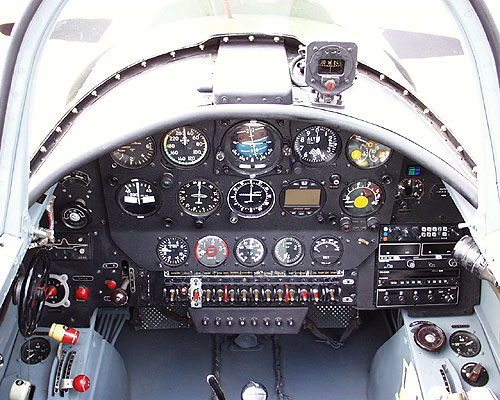
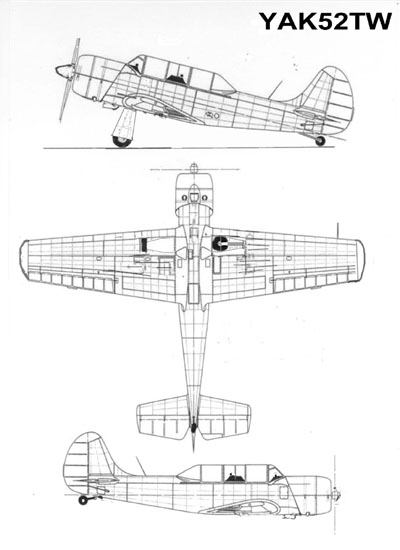
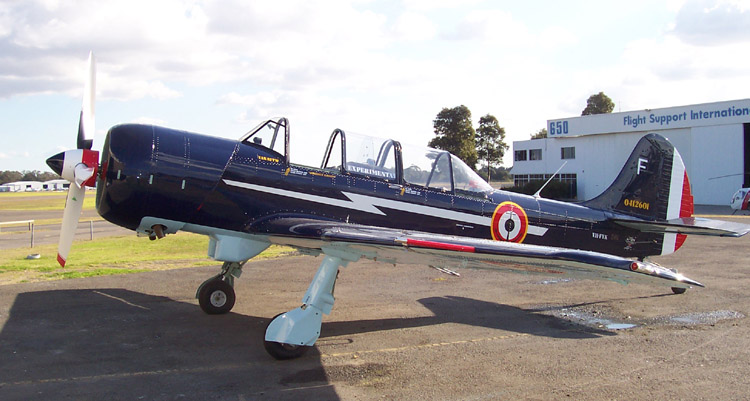
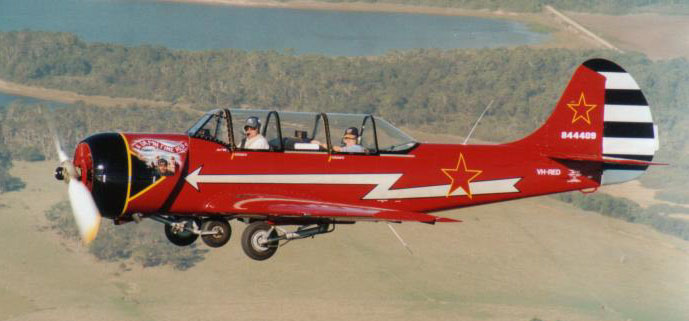
"To be or not to be." Or when is a copy a copy? Nine years ago when I 'discovered' the CJ-6A and fell in love with the airplane, I was told incorrectly that the CJ-6A was a copy of the Yak 18A. It was a popular fable of the time. Even my export shipping paperwork from China had it listed as "CJ-6A/Yak18A". But these two airplanes are very different in design and their actual histories reveal that. It may be that I'm still like Don Quixote, jousting at windmills, but I'm going to try to straighten out some of you diehards. It seems that years ago, most westerners didn't believe (and some still do) that the Chinese were capable of anything but copying Russian stuff aviation wise. This view may have started when the PRC (Peoples Republic of China) started assembling the MIG-15 used during the Korean War. Afterward, the PRC under one of its many "5 year plans" of industrial expansion, started building the Yak-18 (379 aircraft between 1954-1958) for use by their Air Force, Navy, and CAAC. They gave this aircraft the "CJ-5" designation. At the same time they were training young engineering students in their universities to establish an aviation industry. A Mr. Azhou Zhang, a British educated engineer, was responsible for the first ever-static test program in China. This program was tested on the CJ-5 (Yak-18) starting in May 1954.
The first Chinese production CJ-5 flew on July 3, 1954. According to official Chinese literature, the CJ-5 was "totally" manufactured in China. However, Doug Sapp of Omak, WA. who has a Chinese CJ-5 believes that only the major airframe assemblies were actually built. Many of the instruments, wheels, and other small parts had Russian lettering on them. This was bore out in a speech by Bushi Cheng at Manitowoc, Wis., in July 2001 where he noted that at that time the instrument factories were just being built and Russian parts were used. The 5 cylinder M-11FR (160hp), that powered the aircraft, became the first production (under license) aircraft engine in China. In the meantime, a design team, head up by Zhiqian Huang (a US educated aeronautical engineer) and Zhengda Ye (educated in Russia), was assigned the project of designing a jet trainer. Part of that design team, whose average age was 22, was a young man named Bushi Cheng. The "Chief Designer", Shunshou Xu, urged the team to "read 300 Tang dynasty poems and not stick ourselves to just one MIG theory." We might call it 'thinking outside the box' and they did just that. The aircraft they designed was designated the JJ-1, and it first took to the air on July 26, 1958 piloted by Zhenwu Yu. Powered by the PF-1A jet engine, (thrust 3,500 lb.) designed and built at the Shenyang Aero Engine Factory. This was a .5 mach cruise trainer that, according to Bushi Cheng, had excellent handling characteristics. However, development and production were halted because of a change in the Air Forces training program. At one point, the Air Force had planned a three step-training syllabus. Trainees were to be taught the basics in the CJ-6, then moved up to the JJ-1 for introduction into jets, and than up to the UMIG-15 (2 seat MIG-15) for the final training phase. They changed to a two step phase, dropping the need for the JJ-1. The one and only JJ-1 prototype is now located in the Air Force Museum outside of Beijing. The JJ-1 was China's first indigenous designed aircraft.
The need for a better performing basic trainer with a tricycle gear became apparent. The "Yak-18A", derivative of the Yak-18 was available from Russia; however, its performance was disappointing to the Chinese. Importantly too, China was mass-producing aluminum, which was more readily available than the steel used in the Yak-18A's truss airframe. Plus the Chinese were sensing that this was an opportunity to develop further their own indigenous design team that had produced the JJ-1. More simply put, they felt they could design a better aircraft. The first general layout of the design was assigned to the late Jiahua Lin and Bushi Cheng (then 27 year old). In conversations with Bushi Cheng, (now a professor emeritus at a number of universities in China, as well as an author of both text and popular science fiction books plus a concert violinist) I learned that they started their design process by first interviewing numerous flight instructors. They wanted to understand what the instructors wanted in the new airplane. Mainly, they learned that commonality of instrumentation and aircraft operating systems were thought to be the most important. So - if you look inside the CJ-5 and then the CJ-6A, you will see they are practically the same, but that is where the similarity ends. Besides using primarily aluminum-alloy material and a fundamentally different structure, the new design was to use an entirely new power package also. It was an eight-cylinder horizontal opposed air-cooled engine and a new propeller that were in development in Czechoslovakia, known as the "Doris-B". With this engine installed, the CJ-6 prototype's nose sections looked very much like a T-34's. A full-scale wooden mockup was built at the Shenyang Aircraft Factory; however, in May 1958 the development work was moved to the Nanchang Aircraft Factory. Some 5,100 pages of engineering drawings were released to the factory. Interesting note: all of the first airframe's major sub-assemblies were riveted together in 14 days. The final assembly was completed in 7 days by 3 work shifts. A full-scale airframe was used for static tests to destruction and drop tests of the landing gear performed. The prototype with the "Doris-B" engine and prop first flew on August 27, 1958. The test pilots were Yinxi He and Maofan Lu. However, the engine and prop didn't match each other and some "severe technical problems" required a major change. The Czech engine never made it out of development and in July, 1960, the power section was changed to the readily available 9 cylinder radial Soviet A-14P and F530D35 propeller
Flight test on the prototype resumed with the engine change out. This included spin tests performed by Zhaolian Huang a western-trained (USA, England, etc.) pilot. The results of the spin tests showed that no modifications of the basic design were required. Problems found in the prototype's design were: (1) Unbalanced fuel consumption between wing tanks. (2) low engine cylinder temperatures. (3) excessive right yaw and (4) poor oil cooling. Though manageable now, these are the most notable operational characteristics that need to be monitored while flying the CJ-6A even today. The production prototype made its first flight on Oct. 15, 1961. The flight-test program lasted 612 flight hours and included over 1,800 takeoffs and landings. In January 1962, the government approved full-scale production at the Nanchang factory. Then in 1963 the Chinese started producing their own version of the AI-14R nine cylinder radial engine called the HS6 (260 hp). This was the standard engine for the "CJ-6" until 1965 when some production aircraft started getting the HS6A (285-hp) engine. The aircraft designation became the "CJ-6A" with the 285hp engine, which are most of the imports to the US.
Between the years 1964 and 1966 an armed variant of the CJ was produced. However, the records only show that 10 CJ-6As were "retrofitted" at Nanchang factory with hard points for armament and were designated the CJ-6B. It was speculated that the HS6D (300hp) engine was fitted also, however, this engine did not become available until 1975. It is not known if these ten aircraft went into the Chinese military inventory or were for a foreign customer as has been written elsewhere. China's Nanchang factory built 15 aircraft for Albania, 35 for Bangladesh, 50+ for North Korea, 12 to Zambia, with unknown numbers to Tanzania and Cambodia. In mid year (2002) Sri Lanka purchased 10 aircraft for their air force. The CJ-6 is still in limited production, one of the longest in the world. The aircraft also has a new designation, the "CJ-6G". It is available with a variety of modifications, including increased power, increased fuel tank capacity, western avionics, some airframe strengthening, higher maximum gross weight, and even hydraulic brakes. She is still China's first indigenous designed and produced aircraft.
......................................................................................
A very short history of the Yak-18A
The "U" was a straight Yak-18 with the main gear turned around so as to fold forward, then mounted on the rear spar and a nose gear was then placed on the front (very much like its present day prodigy, the Yak-52). It still had the 160-hp M-11-FR-1 engine and performance was considered poor. The 18A was the next design variation. Basically, her nose was lengthened 18 to 21 inches (depending on whom you talk to), wing span increased 12 inches and the 260 hp AI-14R engine installed. She was in direct competition with the CJ-6, who, at that point, shared the same power plant.
Well that's the basic history of the CJ-6A and the Yak-18A. So why is it not a copy of the Yak-18A? "Hey man, they look the same to me!" Below I tried to compare apples to apples. Let's see what happens.
Of particular interest to me is the difference in airfoil sections that make the CJ-6 a distinctly different design from the Yak. The Clark-YH airfoil on the Yak was pre-1933 and was used in a slightly modified form in the real hero of the Battle of Britain, the Hawker Hurricane. The NACA 23000 series airfoils, however, were wartime developments and did not see common use until after the war. The post war Beechcraft Bonanza uses the NACA 23015 airfoil. Note, also, that on the Yak the Clark airfoil is through the whole span while on the CJ-6 the wing sections taper to a NACA 4412, an airfoil suited for the dynamics there. In all, it is a more sophisticated and efficient design. The overall cleaner aerodynamics of the CJ-6, with it's flush riveted wing, has a speed advantage flat out at altitudes. The stowing of the main gear has much to do with this and the Chinese did not sacrifice any strength but actually the design improved ruggedness by using the trailing beam shock absorber. The gear design took into account the many hard landings expected from ham fisted students on rough fields. The one feature that both aircraft share is the cowling for the radial engine they both used. A case now of mistaken identity leading to some believing the CJ-6 was a copy of a Yak. If the Czechoslovakian Doris engine had came to fruition this would not have been the case. So why do aviation folks who should know better, still call the CJ-6 "Yaks"? Part of it is laziness. It's easier to say "Yak" than "CJ-6". Controllers who work all day long with spam cans of Cessnas and Pipers get thrown into confusion by different call signs. It's easier for them to hear and say, 'Yak', and they will know only that when they "see" it, it will look different.
I'd like to use the example of one model of the Lockheed Constellation and Douglas DC-7c. They used the same Wright (3350) engines. They used hydraulics for gear, flaps, and brakes. Their electric systems, I'm told were very much alike, including the make of CBs. There was not much difference in speeds or weight (same class). Their construction was state of the art at the time and therefore similar. However there is not one person who can say they were copies of each other. To many in the airline industry at the time, the "Connie" was the most beautiful and elegant airliner to take to the air. In my conversations with Bushi Cheng, now 73, I could hear the pride he felt in being involved so deeply with the design of the CJ-6. He was a teenager on the streets of Guilin during WWII and remembers being impressed by the pilots of the AVG (Flying Tigers) who flew from there. This led to drawing airplane pictures in his school notebook and finally to the Qinghua University, where he designed his first 'real' airplane as a graduate student. It was a cabin, high wing monoplane, with strut braced fabric covered wings. The fuselage was aluminum monocoque with conventional gear. It had a M-11FR (160hp) engine with a Yak-18 cowling on the nose. It was called the "Diligence" and was a design project for the Shengyang Institute students to build.
In July 2001 our Yak Pilots Association raised money to have Bushi and his wife Yxie, come to our Manitowoc formation clinic and AirVenture 2001. In all these years of being involved in China aviation industry, Bushi Cheng had never gotten a chance to fly in the airplane he designed. I asked why. He looked off into the distance as if looking back then smiled and shrugged his shoulders. "Too busy. No time." Well we made sure that he got to do just that at Manitowoc. There are now some 200 CJ-6As located in the United States. Because of its low acquisition costs, simple systems, rugged reliability, and excellent flying characteristics, it has become a very popular Warbird in the sport aviation community. Most of the aircraft are certified under Experimental Exhibition category that has some minor flight restrictions but is free of expensive STC approved parts requirements. This category also leads to a number of innovative modifications by the individual owners that do not require FAA approval. One of the most popular modifications is the exchange of powerplants from the HS6A (285hp) to the Romania built, Russian designed, M-14P, with 360 hp available. This engine will almost double the rate of climb as well improve altitude performance. The mod is easy to do since the engines have the same physical dimensions plus the cost of a new M-14P is quite reasonable. This change also requires a different propeller and often a new composite 3 bladed prop built by Whirlwind or MT and will add considerable performance.
Another modification often done is to increase the fuel load above the 42 gallons normally available. Adding either internal or external tanks does this. There are several different schemes on internal tank placement. The most popular is putting the tanks behind the main gear wells in the center section. Though not the easiest nor least expensive, but from the standpoint of aerodynamics together with weight and balance considerations, is the best solution. Removal of the out-dated Chinese radios, some 180 lb. of them, is the modification almost mandatory for CJs coming into the US. Installing lightweight western avionics not only allows usability but also allows an increase in payload. Because the original Chinese radios are all located behind the rear seat, their elimination provides an excellent spot for a baggage compartment. A modification of the exhaust system is a change often done for both a safety and a practical reason. The original exhaust pipes, though designed for easy maintenance, are made of a very poor steel material. It rusts out very quickly and could cause a fire hazard. There are a number of vendors who make stainless steel replacement exhaust pipes for the HS6A engine. Since these parts do not require an STC blessing, they are quite reasonable in price. The change out takes less than an hour and a half. As of this writing the factory is now turning out stainless steel pipes for the American market.
With such ease of maintenance, it's excellent handling qualities and the affordable initial cost, its no wonder that the CJ-6A has become very popular, along with its running mate from the communist world, the Yak-52. These 'cold war booty' have allowed an insight into what was the mysterious and dark speculation behind the 'Iron and Bamboo curtains' of their aviation world. With airplanes like the CJ-6A, it is now possible to see the insights on how other people perceived what was needed in a flying machine and how their life experiences and values affected their designs. They produced great airplanes that may not go down in our history as such but are very significant in theirs. The CJ-6 was a product of great changes taking place in China and, like its culture, it was definitely not a copy. Checklist: Helmet strapped down. Visor closed. Boots in stirrups. Monster in sight. Lower lance. Charge! |

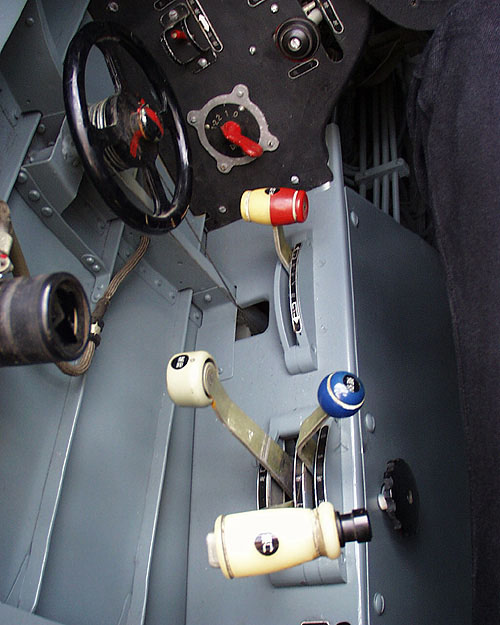







 Believe it or not, some CJ owners still think the CJ is a copy of a
Yak. They like to point out the engine, the pneumatic system, the
instruments etc. etc. They think that the systems make the airplane;
but they don't because 'systems' are common to all aircraft. A wheel
is a wheel, be it on a Piper or Cessna. The same manufacturer of a
tire, tube, rim, and brakes may be used on several makes and designs
of aircraft. It's the same for engines, instruments, and avionics
packages.
Believe it or not, some CJ owners still think the CJ is a copy of a
Yak. They like to point out the engine, the pneumatic system, the
instruments etc. etc. They think that the systems make the airplane;
but they don't because 'systems' are common to all aircraft. A wheel
is a wheel, be it on a Piper or Cessna. The same manufacturer of a
tire, tube, rim, and brakes may be used on several makes and designs
of aircraft. It's the same for engines, instruments, and avionics
packages. 

